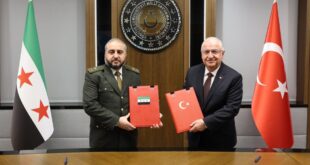OCCUPIED JERUSALEM — It is a moot point whether the Palestinian uprising is over. A new phase of conflict is already taking shape in the Middle East.
Fighting still centres on the Gaza Strip following Israel’s withdrawal from the territory after 38 years of occupation, but both sides concur that the West Bank is more likely to be the bigger battleground in years to come.
A truce in February largely cooled the uprising that erupted on Sept. 28, 2000, and the calm helped smooth Israel’s pullout from the Gaza Strip — a move that Washington hopes will serve to revive peace-making.
However, fighting in recent days has added to pessimism over ending decades of Israeli-Palestinian conflict in a land beset by war pretty much since history was written down.
Israel pursued an air offensive in Gaza on Wednesday in response to rocket fire from the territory. It also had the aim, as Defence Minister Shaul Mofaz put it, of teaching the new “rules of the game.”
For Israel, that means at least the same tacit agreement as with Hizbollah fighters on a northern border that has been generally quiet since Israel left southern Lebanon in 2000.
If they fire, they expect fierce air retaliation.
Meanwhile, the Gaza pullout has made it harder for that territory’s fighters to launch deadly attacks on Israelis by removing from range the 8,500 Jewish settlers and the thousands of soldiers guarding them.
Rocket fire into border towns from Gaza terrifies Israelis, but rarely kills.
Turn to West Bank
Quite apart from the military considerations, there is a very real desire among Gaza residents for a spell of quiet that could allow them to end internal disorder and make the territory a real testing ground for statehood.
Hamas said it would end rocket fire from Gaza after Israel began its offensive and some other groups have followed suit.
The Palestinian fighters’ argument is that the first five years of conflict drove Israel out of Gaza settlements.
Next steps are the West Bank — where Israel continues expanding Jewish settlements — and East Jerusalem, areas also occupied by Israel since the 1967 war which Palestinians hope to have for a state.
The official aim of Hamas is to go beyond that and destroy Israel completely.
Factions reject disarmament, which Palestinians were meant to start under a “roadmap” peace plan and Israel sets as a condition for statehood talks. President Mahmoud Abbas shows no sign of disarming them by force, as Israel wants.
“Gaza is the first liberation, then comes the West Bank, then every inch of Palestinian land,” stressed top Hamas official Khaled Mishaal as Israel evacuated Gaza settlers.
Israel believes it has had a taste of what may be to come.
Sasson Nuriel, an Israeli abducted between his home and the West Bank settlement where he worked, sat blindfolded in front of a green Hamas flag in a video released on Tuesday that recalled those of Iraqi insurgents.
Nuriel was killed and his body found on Monday.
“The film indicates that Hamas intends to continue with the kidnappings, but also that the main terror activity is moving from the Gaza Strip to the West Bank,” said Amos Harel in the Haaretz newspaper.
Yuval Diskin, head of Israel’s Shin Bet security service, has said Israel is also worried about technology for makeshift missiles moving to the West Bank and within range of major Israeli cities.
West Bank tougher
However, waging war from the West Bank, where Israel has arrested hundreds of suspected fighters in recent days, is tougher than from Gaza.
The army has far more control and access in the West Bank, where cities are divided by Israeli roads and settlements.
There is also more than a grain of truth in the old quip that the Shin Bet, which runs networks of Palestinian informers, is the territory’s biggest employer.
Factions acknowledge that Israel’s West Bank barrier, condemned by Palestinians as a land grab for looping into occupied land, has made it harder to get suicide bombers — their most effective weapon — into the Jewish state.
Tunnelling through the West Bank’s rocky ground into well-guarded hilltop settlements is much more difficult than mining the sandy terrain of the Gaza Strip.
“It is not as easy to attack these settlements,” said Nasser Abu Aziz of Aqsa Brigades in Nablus, clutching a cushion at a hideout as he explains how he hopes fighting will end so he can go back to his day job in Palestinian security forces.
“If we have to fight, then I would concentrate on trying to find ways to get bombers in,” he said.
Roads leading past the barrier to isolated West Bank settlements have been obvious gaps for fighters to try to penetrate.
Another potential soft spot is East Jerusalem, which Palestinians want for their eventual capital and Israel has annexed in a move recognised only by itself.
Palestinians in East Jerusalem are able to move freely in Israel but, while some have been involved in helping attacks during the uprising, they have not played a leading role.
Israeli security services now believe fighters are targeting residents for recruitment as a way of getting a foothold on the other side of the barrier.
In the meantime, barrier sections being built in Jerusalem split Palestinian communities and cut them off from services while Israel expands its Jewish settlements there and emphasises it will never give up the eastern part of the city.
“That will be an explosive mix,” said a recent report by the International Crisis Group think tank.
 Eurasia Press & News
Eurasia Press & News



